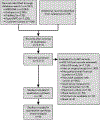Financial Burdens of Cancer Treatment: A Systematic Review of Risk Factors and Outcomes
- PMID: 31590147
- PMCID: PMC7370695
- DOI: 10.6004/jnccn.2019.7305
Financial Burdens of Cancer Treatment: A Systematic Review of Risk Factors and Outcomes
Abstract
Background: Patients with cancer experience financial toxicity from the costs of treatment, as well as material and psychologic stress related to this burden. A synthesized understanding of predictors and outcomes of the financial burdens associated with cancer care is needed to underpin strategic responses in oncology care. This study systematically reviewed risk factors and outcomes associated with financial burdens related to cancer treatment.
Methods: MEDLINE, Embase, PubMed, PsychINFO, and the Cochrane Library were searched from study inception through June 2018, and reference lists were scanned from studies of patient-level predictors and outcomes of financial burdens in US patients with cancer (aged ≥18 years). Two reviewers conducted screening, abstraction, and quality assessment. Variables associated with financial burdens were synthesized. When possible, pooled estimates of associations were calculated using random-effects models.
Results: A total of 74 observational studies of financial burdens in 598,751 patients with cancer were identified, among which 49% of patients reported material or psychologic financial burdens (95% CI, 41%-56%). Socioeconomic predictors of worse financial burdens with treatment were lack of health insurance, lower income, unemployment, and younger age at cancer diagnosis. Compared with patients with health insurance, those who were uninsured demonstrated twice the odds of financial burdens (pooled odds ratio [OR], 2.09; 95% CI, 1.33-3.30). Financial burdens were most severe early in cancer treatment, did not differ by disease site, and were associated with worse health-related quality of life (HRQoL) and nearly twice the odds of cancer medication nonadherence (pooled OR, 1.70; 95% CI, 1.13-2.56). Only a single study demonstrated an association with increased mortality. Studies assessing the comparative effectiveness of interventions to mitigate financial burdens in patients with cancer were lacking.
Conclusions: Evidence showed that financial burdens are common, disproportionately impacting younger and socioeconomically disadvantaged patients with cancer, across disease sites, and are associated with worse treatment adherence and HRQoL. Available evidence helped identify vulnerable patients needing oncology provider engagement and response, but evidence is critically needed on the effectiveness of interventions designed to mitigate financial burden and impact.
Figures




Similar articles
-
Financial toxicity is associated with worse physical and emotional long-term outcomes after traumatic injury.J Trauma Acute Care Surg. 2019 Nov;87(5):1189-1196. doi: 10.1097/TA.0000000000002409. J Trauma Acute Care Surg. 2019. PMID: 31233442 Free PMC article.
-
Beyond the black stump: rapid reviews of health research issues affecting regional, rural and remote Australia.Med J Aust. 2020 Dec;213 Suppl 11:S3-S32.e1. doi: 10.5694/mja2.50881. Med J Aust. 2020. PMID: 33314144
-
The financial toxicity of cancer: unveiling global burden and risk factors - a systematic review and meta-analysis.BMJ Glob Health. 2025 Feb 10;10(2):e017133. doi: 10.1136/bmjgh-2024-017133. BMJ Glob Health. 2025. PMID: 39929536 Free PMC article.
-
Financial toxicity: A practical review for gynecologic oncology teams to understand and address patient-level financial burdens.Gynecol Oncol. 2023 Mar;170:317-327. doi: 10.1016/j.ygyno.2023.01.035. Epub 2023 Feb 7. Gynecol Oncol. 2023. PMID: 36758422 Review.
-
Patient-reported financial toxicity, quality of life, and health behaviors in insured US cancer survivors.Support Care Cancer. 2021 Jan;29(1):349-358. doi: 10.1007/s00520-020-05468-z. Epub 2020 May 3. Support Care Cancer. 2021. PMID: 32361832 Free PMC article.
Cited by
-
Do advance directive attitudes and perceived susceptibility and end-of-life life-sustaining treatment preferences between patients with heart failure and cancer differ?PLoS One. 2020 Sep 8;15(9):e0238567. doi: 10.1371/journal.pone.0238567. eCollection 2020. PLoS One. 2020. PMID: 32898165 Free PMC article.
-
Association between cognitive impairment and oral anticancer agent use in older patients with metastatic renal cell carcinoma.J Am Geriatr Soc. 2022 Aug;70(8):2330-2343. doi: 10.1111/jgs.17826. Epub 2022 May 2. J Am Geriatr Soc. 2022. PMID: 35499667 Free PMC article.
-
Social Wellbeing in Cancer Survivorship: A Cross-Sectional Analysis of Self-Reported Relationship Closeness and Ambivalence from a Community Sample.Curr Oncol. 2023 Jan 31;30(2):1720-1732. doi: 10.3390/curroncol30020133. Curr Oncol. 2023. PMID: 36826094 Free PMC article.
-
Accountable care in oncology: Where do we go from here?Cancer. 2022 Mar 1;128(5):950-952. doi: 10.1002/cncr.34021. Epub 2021 Nov 12. Cancer. 2022. PMID: 34767645 Free PMC article.
-
CAR T cells and checkpoint inhibition for the treatment of glioblastoma.Expert Opin Biol Ther. 2020 Jun;20(6):579-591. doi: 10.1080/14712598.2020.1727436. Epub 2020 Feb 17. Expert Opin Biol Ther. 2020. PMID: 32027536 Free PMC article. Review.
References
-
- Azzani M, Roslani AC, Su TT. The perceived cancer-related financial hardship among patients and their families: a systematic review. Support Care Cancer 2015;23:889–898. - PubMed
-
- Miller KD, Siegel RL, Lin CC, et al. Cancer treatment and survivorship statistics, 2016. CA Cancer J Clin 2016;66:271–289. - PubMed
-
- Institute of Medicine. Ensuring Patient Access to Affordable Cancer Drugs: Workshop Summary. Washington, DC: National Academies Press; 2014. - PubMed
-
- Soni A Trends in use and expenditures for cancer treatment among adults 18 and older, U.S. civilian noninstitutionalized population, 2001 and 2011 Statistical Brief #443. Rockville, MD: Agency for Healthcare Research and Quality; 2014. - PubMed
-
- Dusetzina SB, Winn AN, Abel GA, et al. Cost sharing and adherence to tyrosine kinase inhibitors for patients with chronic myeloid leukemia. J Clin Oncol 2014;32:306–311. - PubMed
Publication types
MeSH terms
Grants and funding
LinkOut - more resources
Full Text Sources
Medical

